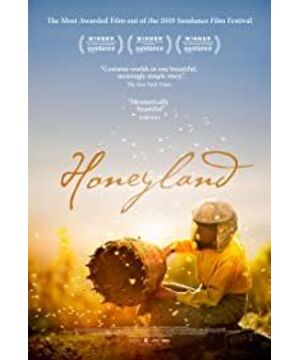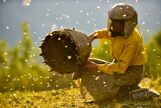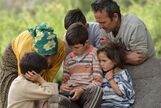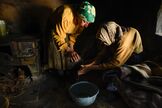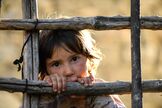Through another year of Oscar nominations, I learned about this documentary.
I originally thought that there would be a detailed background introduction or basic character introduction in the documentary, but I found that there is no such thing. From the beginning of the screening, the story has been flowing like this quietly, both quiet and noisy. It is not so much a documentary as it is a drama from the depths of nature.
The heroine seems to be an ancient human who is far away from human civilization. Whether it is the way of bee-picking and bee-keeping that she relies on for a living, or her daily life, the songs she hums, and the dim candlelight will make people escape from the 21st century. to an older age. People in their fifties can see the thoughts of their young girls everywhere. With a bright yellow top, a matching skirt, and a green headscarf, dark but still firm skin, with a little firework and sunset, every frame under the lens can be drawn into the picture. When I was worried about how to make a living in a poor environment, the hostess bought a relatively expensive hair dye immediately after selling honey at the market. So off-screen I would feel that this way of life is quite poor and backward, and it is difficult to make a living, but the protagonist may have no concept of poverty. One day, in the long river of life, but like a bee.
The arrival of the nomadic family broke this balance. The days started to get rowdy. My husband is trying to find ways to make ends meet, but I don't see the end of my life out of this poverty. Because all this is growing savagely. Think that children are an asset, but children are not well cared for and educated. Although the husband has never been violent, his tyranny is imposed on the family every day. The children wandered around like this, chasing the herd, frolic and even fighting. As for going to school, it is impossible to imagine when and where they will be educated.
The bee and the heroine seem to have a more intimate relationship, a relationship of taming and being tamed. And since the nomadic family of beekeeping, the picture of bees and people is always a mess. Stings everywhere, there are a few shots, the girl's eyes are swollen and swollen, staring blankly, how intriguing. Children are more likely to believe in the gods of nature and understand the principle of "take half and keep half", but they are powerless to fight against the head of the family. Sometimes it seems that this typical unbridled greed stems from the root of poverty, from the desire to get out of trouble quickly, but when their family swept away and everything was peaceful again, it was found: Oh, so they are not. does not belong here. There will be the next place, the foothold of their savage plunder.
Two impressive shots.
Saw the birth of a calf for the first time. At that time, I didn't know what the child was pulling behind the cow. Later, when the head of the cow came out, it was realized that it was helping to "deliver the birth". During the whole process, the child can be described as bold and careful, and should have been exposed to this kind of thing more than once. Although the process is simple and rude, the power of nature is growing recklessly, not only for cattle, but also for children.
The mother of the heroine once, after arguing with the heroine, kept asking the heroine's cheek like a child. In fact, I feel that the elderly mother is more like a baby, and the heroine is more like a mother. Only later did I learn that, according to ancient customs, the last daughter in the family must take care of her parents, and she was not allowed to marry until they passed away. This explains why the heroine has been alone with her mother. More than once, she would have said that if the mother were a baby, she would have taken her away from this place. But my mother is a perennial bedridden old man. This seems to have trapped her life here, like a mission.
Plus, the lighting for photography is beautiful.
View more about Honeyland reviews


